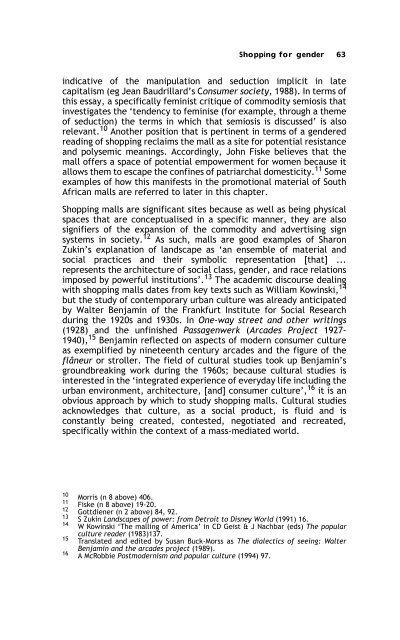Sex, Gender, Becoming - PULP
Sex, Gender, Becoming - PULP
Sex, Gender, Becoming - PULP
Create successful ePaper yourself
Turn your PDF publications into a flip-book with our unique Google optimized e-Paper software.
Shopping for gender 63<br />
indicative of the manipulation and seduction implicit in late<br />
capitalism (eg Jean Baudrillard’s Consumer society, 1988). In terms of<br />
this essay, a specifically feminist critique of commodity semiosis that<br />
investigates the ‘tendency to feminise (for example, through a theme<br />
of seduction) the terms in which that semiosis is discussed’ is also<br />
relevant. 10 Another position that is pertinent in terms of a gendered<br />
reading of shopping reclaims the mall as a site for potential resistance<br />
and polysemic meanings. Accordingly, John Fiske believes that the<br />
mall offers a space of potential empowerment for women because it<br />
allows them to escape the confines of patriarchal domesticity. 11 Some<br />
examples of how this manifests in the promotional material of South<br />
African malls are referred to later in this chapter.<br />
Shopping malls are significant sites because as well as being physical<br />
spaces that are conceptualised in a specific manner, they are also<br />
signifiers of the expansion of the commodity and advertising sign<br />
systems in society. 12 As such, malls are good examples of Sharon<br />
Zukin’s explanation of landscape as ‘an ensemble of material and<br />
social practices and their symbolic representation [that] ...<br />
represents the architecture of social class, gender, and race relations<br />
imposed by powerful institutions’. 13 The academic discourse dealing<br />
with shopping malls dates from key texts such as William Kowinski, 14<br />
but the study of contemporary urban culture was already anticipated<br />
by Walter Benjamin of the Frankfurt Institute for Social Research<br />
during the 1920s and 1930s. In One-way street and other writings<br />
(1928) and the unfinished Passagenwerk (Arcades Project 1927-<br />
1940), 15 Benjamin reflected on aspects of modern consumer culture<br />
as exemplified by nineteenth century arcades and the figure of the<br />
flâneur or stroller. The field of cultural studies took up Benjamin’s<br />
groundbreaking work during the 1960s; because cultural studies is<br />
interested in the ‘integrated experience of everyday life including the<br />
urban environment, architecture, [and] consumer culture’, 16 it is an<br />
obvious approach by which to study shopping malls. Cultural studies<br />
acknowledges that culture, as a social product, is fluid and is<br />
constantly being created, contested, negotiated and recreated,<br />
specifically within the context of a mass-mediated world.<br />
10 Morris (n 8 above) 406.<br />
11<br />
Fiske (n 8 above) 19-20.<br />
12 Gottdiener (n 2 above) 84, 92.<br />
13 S Zukin Landscapes of power: from Detroit to Disney World (1991) 16.<br />
14<br />
W Kowinski ‘The malling of America’ in CD Geist & J Nachbar (eds) The popular<br />
15<br />
culture reader (1983)137.<br />
Translated and edited by Susan Buck-Morss as The dialectics of seeing: Walter<br />
16<br />
Benjamin and the arcades project (1989).<br />
A McRobbie Postmodernism and popular culture (1994) 97.
















